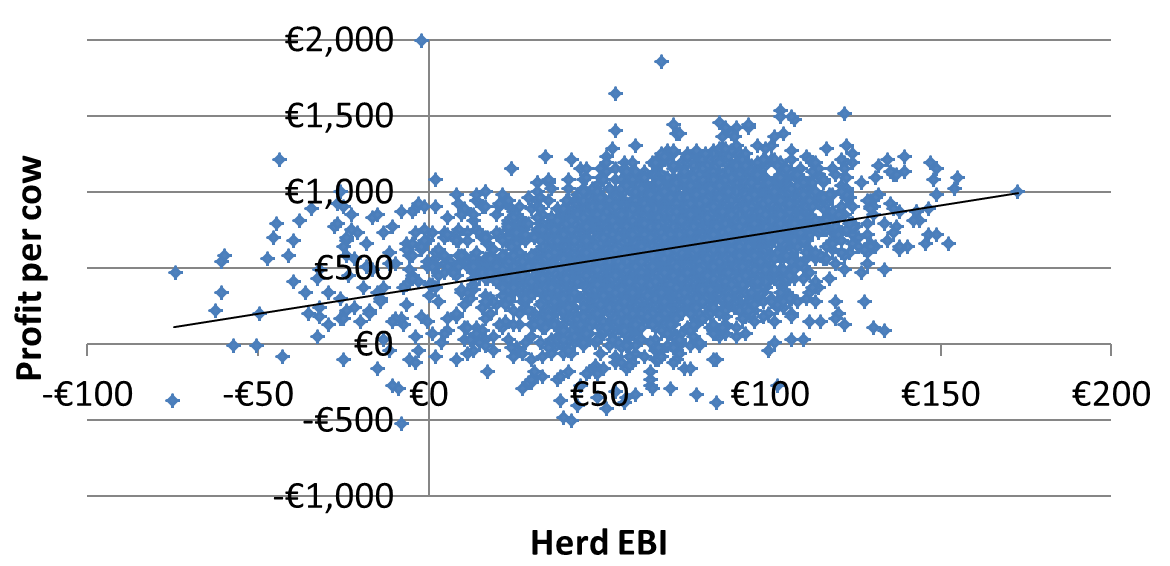Latest work by Teagasc has indicated that each €1 gain in herd EBI is worth €1.96 in terms of additional net profit per cow per year. Applying these figures to a herd with an EBI of €130 (equivalent to the top 1% of herds nationally) relative to the average herd (at €70), would equate to a difference of €118/cow/year, or €11,800 for a 100 cow herd.
Validating the EBI
The objective of the exercise undertaken by Teagasc was to validate if EBI was actually delivering at farm level. Ireland is the only country in the world where a large database of farm financial data (the E-Profit Monitor) can be used to confirm if the national dairy genetic database, the herd EBI, is actually delivering on the ground.
If the science is correct, then each €1 increase in EBI should result in a €2 gain in net profit/ cow. A previous validation analysis was completed during the milk quota era and included herd genetic and financial data for period 2008-2011. At that time, Teagasc established that each €1 increase in herd EBI was associated with a €1.94 increase in net profit per cow per year.
Latest Analysis
Dairy Profit Monitor data from spring calving herds for the 2012-2016 period was collated with herd EBI data for the same years. A total of 4,500 herd records were included in the analysis. Only herds with a minimum of 70% of their cows with EBI data were retained for the analysis (to ensure that the researchers had a good handle on the genetic level of the herd). In addition, only herds that were predominantly Black & White were retained for this analysis, as the exercise was to establish the relationship between herd EBI and net profit/cow, separate from any influence of heterosis.
For the analysis all herd years were adjusted to the 2016 EBI base. In addition, net profit per cow was adjusted to a standard base milk price (base 30 c/litre) with bonuses for higher fat and protein content, region of the country and year. For the exercise, fat was valued at €2.95/kg, protein at €6.78/kg and milk volume at -0.04 cents/litre. A summary of the physical and financial data from the dataset is presented in Table 1.
The data in Table 1 clearly indicates that the farms included in the dataset are generally higher than average for herd EBI, milk yield, stocking rate, grass used and financial performance. As the sample is not matched across years, no yearly trends can be inferred from the data.
| Table 1. Summary of farm and financial data for herds included in the Teagasc EBI Validation Study | |||||||
| Year | No. Farms | Herd Ave EBI | Herd Ave Milk SI/ Fert SI | MS YIELD kg/litres/cow | SR (LU/ha) ) / Grass used (t DM/ha) | Meal Fed (kg/cow) | Net Profit (€/cow) |
| 2012 | 665 | 50 | €2/€27 | 394/5,124 | 2.17/8.0 | 1,023 | 586 |
| 2013 | 1,052 | 60 | €7/€33 | 402/5,246 | 2.15/7.5 | 1,261 | 788 |
| 2014 | 848 | 68 | €11/€37 | 408/5,234 | 2.16/8.4 | 928 | 859 |
| 2015 | 821 | 75 | €15/€38 | 447/5,699 | 2.22/9.2 | 936 | 677 |
| 2016 | 1,111 | 78 | €16/€37 | 436/5,552 | 2.21/9.0 | 955 | 494 |
Correlating Herd EBI and Net Profit data.
The next and most significant aspect of the analysis was to correlate the relationship between herd EBI and net profit per cow (Figure 1). The trends from Figure 1 indicate a clear relationship between herd EBI and profit, with each €1 gain in herd EBI being worth €1.96 in terms of net profit per cow, which is exceptionally close to the expected €2 profit per cow per €1 EBI increase.

The data from figure 1 also highlights that there is wide variation between herd EBI and net profit per cow. This is not surprising given that many other factors unrelated to herd EBI could also influence profit – for example high depreciation cost per cow could reduce profit per cow in a high EBI herd.
These findings confirm two things:
• Firstly, that the EBI model has held well as the dairy industry transitions from a quota to a post-quota environment;
• Secondly that selecting bulls on the basis of EBI remains the appropriate choice for profit focused dairy farmers.
Acknowledgement
ICBF would like to acknowledge George Ramsbottom, Dairy specialist, Teagasc Carlow and Dr Donagh Berry, Principal Research Officer, Teagasc Moorepark for undertaking this important work.
